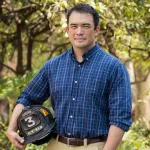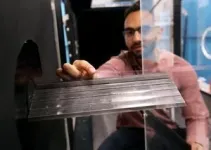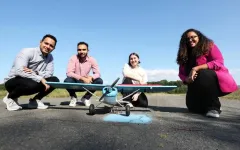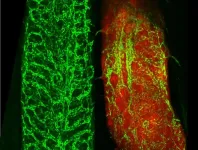(Press-News.org) Derek Urwin has a special stake in his work as a cancer control researcher. After undergraduate studies in applied mathematics at UCLA, he became a firefighter. His inspiration to launch a second career as a scientist was the loss of his brother, Isaac, who died of leukemia at only 33 despite no history of cancer in their family. Working with Anastassia Alexandrova, a professor of chemistry and biochemistry in the UCLA College, he earned his doctorate.
Urwin is now a UCLA adjunct professor of chemistry — and still a full-time firefighter with the Los Angeles County Fire Department. In a recent publication, his science shed new light on the chemical underpinnings of exposures that may lead to cancer.
When organic substances burn, the smoke carries compounds known as polycyclic aromatic hydrocarbons, or PAHs. PAHs can enter the body through breathing, eating, drinking and skin contact. Because emissions from industry and automobiles are one source, nearly everyone encounters these chemicals in day-to-day life. Certain jobs such as firefighting and coal-tar production expose workers to concentrated doses of PAHs — the same jobs that tend to be associated with increased risk for cancer.
In fact, the International Agency for Research on Cancer has listed many PAHs as probable or possible carcinogens. Only one among these thousands of chemicals, benzo[a]pyrene (B[a]P), is classified as a known carcinogen in humans.
A study by Urwin, Alexandrova and UCLA undergraduate Elise Tran published in the Proceedings of the National Academy of Sciences shows that some of B[a]P’s chemical cousins may present more serious risk for cancer. The scientists used computer simulations of molecular interactions to profile what happens when each of 15 PAHs settles onto a spot in the DNA helix commonly linked to cancer-causing mutations. Compared to the known carcinogen, six of the PAHs showed a greater affinity for binding to the mutational hotspot. Those six chemicals also had a higher likelihood of avoiding detection by a crucial mechanism for repairing DNA lesions.
At left is a molecule that is a known carcinogen, and at right a chemical cousin. The green dashes surround an extra space that might connect to DNA; that space is obscured inside the orange dashes.
In addition to the new insight about the relative toxicity of PAHs, the research may offer a faster way to filter potentially dangerous chemicals and identify which ones are riskiest to human health. Such findings could inform not only laboratory and population studies but also public policy.
“We hope that our strategy can speed up the process of studying these chemicals,” said Urwin, the study’s first author. “Instead of casting a wide net, this could show exactly where we ought to start the process. Efficient, effective, accurate computational studies can even enhance or accelerate the process of developing policy that improves public and occupational health.”
Urwin also serves as chief science advisor for the International Association of Fire Fighters and was recently appointed to the California Occupational Safety and Health Standards Board.
“Derek’s work as a firefighter made this research possible,” said corresponding author Alexandrova, who is a member of the California NanoSystems Institute at UCLA. “He knows what’s going on in the field very intimately, and that enables us to make the connection to chemistry and the tools that we have. Real-life experience educated us about what to do.”
Credit is also due to Urwin’s intuition. The germ of the investigation was his observation that, based on their structure, several PAHs simply looked as though they ought to fit more snugly within the DNA double helix than others, where they insert themselves like a key into a keyhole.
The investigators built on previous research in which they applied an advanced algebraic technique to accurately model PAHs’ atomic interactions. They compared how strongly B[a]P and 14 other PAHs bind to a DNA sequence that is mutated in one third of all human cancers.
The team plans to apply their computational method to other genetic hot spots related to cancer, as well as to more PAHs and other compounds, including the “forever chemicals” known as PFAS.
With connections to the world of firefighting and science, Urwin also relishes the opportunity for community-based participatory research. In that model, the people being studied help shape the questions being asked, the design and execution of the research, and the dissemination of resulting information to those affected in a way that they understand.
“My fellow firefighters have historically been underserved by the scientific community, not out of disdain, but rather because it’s complicated to conduct research in the midst of emergency service operations,” Urwin said. “Having my feet in both arenas, I want to bring access to scientists, so their research can create a positive impact on health in the fire service community. Science is supposed to make the world better for people, whether it’s firefighters or anyone else.”
END
Chemicals produced by fires show potential to raise cancer risk
Simulations reveal PAHs’ affinity for binding to DNA — and evading repair — in study co-led by county firefighter
2024-10-28
ELSE PRESS RELEASES FROM THIS DATE:
Penn Nursing awarded $3.2 million grant to improve firearm safety
2024-10-28
PHILADELPHIA (October 28, 2024) – The University of Pennsylvania School of Nursing (Penn Nursing) has been awarded a $3.2 million, 5-year grant from the National Institute of Nursing Research (NINR) to scale out an evidence-based secure firearm storage intervention at Children’s Hospital of Philadelphia (CHOP). Firearms are now the leading cause of death for U.S. children and teens, driving the largest spike in children’s mortality in more than 50 years. The study aims to keep children safer from firearm injury and mortality by promoting secure firearm storage.
The intervention, ...
Bird wings inspire new approach to flight safety
2024-10-28
Taking inspiration from bird feathers, Princeton engineers have found that adding rows of flaps to a remote-controlled aircraft’s wings improves flight performance and helps prevent stalling, a condition that can jeopardize a plane’s ability to stay aloft.
“These flaps can both help the plane avoid stall and make it easier to regain control when stall does occur,” said Aimy Wissa, assistant professor of mechanical and aerospace engineering and principal investigator of the study, published in the Proceedings ...
Global fleet of undersea robots reveal the phytoplankton hidden beneath the ocean's surface
2024-10-28
Marine phytoplankton are fundamental to Earth’s ecology and biogeochemistry. Our understanding of the large-scale dynamics of phytoplankton biomass has greatly benefited from, and is largely based on, satellite ocean color observations from which chlorophyll-a (Chla), a commonly used proxy for carbon biomass, can be estimated. However, ocean color satellites only measure a small portion of the surface ocean, meaning that subsurface phytoplankton biomass is not directly monitored. Chla is also an imperfect ...
Climate, dead zones and fish: Solving a 'wicked problem' in Lake Erie and beyond
2024-10-28
Images
There's a famous piece of advice from hockey, attributed to Wayne Gretzky, about how it's better to skate to where the puck is headed rather than where it is.
Research is now showing that regulations designed to protect Lake Erie's water quality are heeding the Great One's words when it comes to safeguarding the Great Lake's fisheries.
Specifically, the currently recommended limits on the flow of nutrients into Lake Erie from agriculture may be too restrictive for some species of fish. They are, however, suited to maintain healthy fisheries until the ...
Dinosaurs thrived after ice, not fire, says a new study of ancient volcanism
2024-10-28
201.6 million years ago, one of the Earth's five great mass extinctions took place, when three-quarters of all living species suddenly disappeared. The wipeout coincided with massive volcanic eruptions that split apart Pangaea, a giant continent then comprising almost all the planet's land. Millions of cubic miles of lava erupted over some 600,000 years, separating what are now the Americas, Europe and North Africa. It marked the end of the Triassic period and the beginning of the Jurassic, the period when dinosaurs arose to take the place of Triassic creatures and dominate the planet.
The exact mechanisms of the End Triassic Extinction have long been debated, ...
Green growth: 30% of regions worldwide achieve economic growth while reducing carbon emissions
2024-10-28
“We found that 30 percent of the regions with available data have fully decoupled carbon emissions from economic growth. Regions with high incomes and a history of carbon-intensive industries, as well as those with significant shares of service and manufacturing sectors were particularly successful in reducing carbon emissions while still experiencing economic growth,“ says Anders Levermann, co-author and head of the research department “Complexity Science” at PIK. “A stabilization of the global mean temperature is only possible with net-zero carbon emissions. That ...
Cellular couriers: Body's ‘delivery trucks’ could lead to new cancer blood test
2024-10-28
A landmark study led by WEHI and La Trobe University has found a potential new diagnostic marker that could be used to better detect the level of tissue damage in our bodies.
Extracellular vesicles (EVs) are small ‘delivery trucks’ released by our cells that deliver important materials to other cells to aid cellular communication. This study revealed, for the first time, a link between levels of EVs in the blood and tissue damage caused by diseases such as leukaemia.
Researchers hope to leverage the ...
Public and community engagement key to enhancing urban living conditions and environmental decision making in China, study says
2024-10-28
Public and community engagement in decision making is key to enhancing urban living conditions and the environment in China, a new study says.
There has been significant progress through legislation to promote the role of citizens in environment and nature-based solutions (NBS), but progress in involving the public in projects has been limited, the research shows.
However, there has been some work in gathering public opinion and involving them in the project design and decision-making of government-led and large NBS projects.
Researchers found smaller local NBS projects tend to see higher levels of public participation, ...
Bagheri to leverage recycled polyurethane foam for real-world applications
2024-10-28
Bagheri To Leverage Recycled Polyurethane Foam For Real-World Applications Shaghayegh Bagheri, Assistant Professor, Mechanical Engineering, College of Engineering and Computing (CEC), received funding for the project: “Leveraging Recycled Polyurethane Foam for Real-world Applications.”
Bagheri ...
Seeing a black hole's jet in a new light
2024-10-28
Image
Research led by the University of Michigan has pored over more than two decades' worth of data from NASA's Chandra X-Ray Observatory to show there's new knotty science to discover around black holes.
In particular, the study looks at the high-energy jet of particles being blasted across space by the supermassive black hole at the center of the galaxy Centaurus A.
Jets are visible to different types of telescopes, including those that detect radio waves and others that collect X-rays. Since Chandra's 1999 launch, many astronomers have been particularly interested ...
LAST 30 PRESS RELEASES:
Age-related changes in sperm DNA may play a role in autism risk
Ambitious model fails to explain near-death experiences, experts say
Multifaceted effects of inward foreign direct investment on new venture creation
Exploring mutations that spontaneously switch on a key brain cell receptor
Two-step genome editing enables the creation of full-length humanized mouse models
Pusan National University researchers develop light-activated tissue adhesive patch for rapid, watertight neurosurgical sealing
Study finds so-called super agers tend to have at least two key genetic advantages
Brain stimulation device cleared for ADHD in the US is overall safe but ineffective
Scientists discover natural ‘brake’ that could stop harmful inflammation
Tougher solid electrolyte advances long-sought lithium metal batteries
Experts provide policy roadmap to reduce dementia risk
New 3D imaging system could address limitations of MRI, CT and ultrasound
First-in-human drug trial lowers high blood fats
Decades of dredging are pushing the Dutch Western Scheldt Estuary beyond its ecological limits
A view into the innermost workings of life: First scanning electron microscope with nanomanipulator inaugurated in hesse at Goethe University
Simple method can enable early detection and prevention of chronic kidney disease
S-species-stimulated deep reconstruction of ultra-homogeneous CuS nanosheets for efficient HMF electrooxidation
Mechanical and corrosion behavior of additively manufactured NiTi shape memory alloys
New discovery rewrites the rules of antigen presentation
Researchers achieve chain-length control of fatty acid biosynthesis in yeast
Water interactions in molecular sieve catalysis: Framework evolution and reaction modulation
Shark biology breakthrough: Study tracks tiger sharks to Maui mating hub
Mysterious iron ‘bar’ discovered in famous nebula
World-first tool reduces harmful engagement with AI-generated explicit images
Learning about public consensus on climate change does little to boost people’s support for action, study shows
Sylvester Cancer Tip Sheet for January 2026
The Global Ocean Ship-Based Hydrographic Investigations Program (GO-SHIP) receives the Ocean Observing Team Award
Elva Escobar Briones selected for The Oceanography Society Mentoring Award
Why a life-threatening sedative is being prescribed more often for seniors
Findings suggest that certain medications for Type 2 diabetes reduce risk of dementia
[Press-News.org] Chemicals produced by fires show potential to raise cancer riskSimulations reveal PAHs’ affinity for binding to DNA — and evading repair — in study co-led by county firefighter







